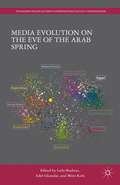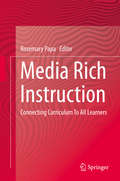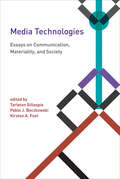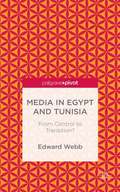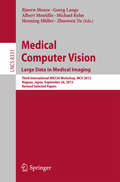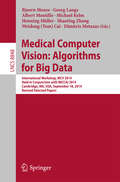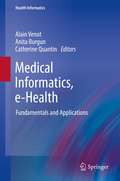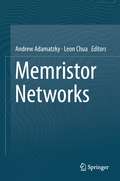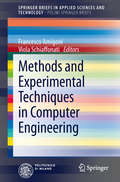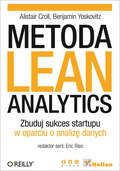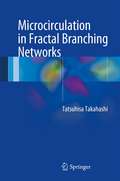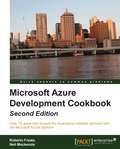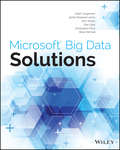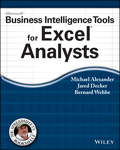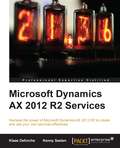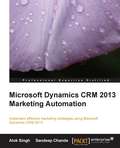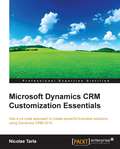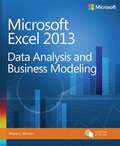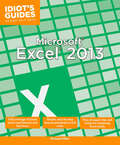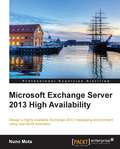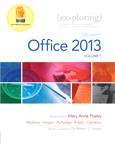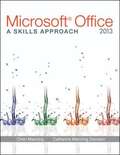- Table View
- List View
Media Evolution On The Eve Of The Arab Spring
by Mimi Kirk Adel Iskandar Leila HudsonMedia Evolution on the Eve of the Arab Spring brings together some of the most celebrated and respected names in Arab media research to reflect on the communication conditions that preceded and made the Arab uprisings possible.
Media Rich Instruction
by Rosemary PapaE-learning has brought an enormous change to instruction, in terms of both rules and tools. Contemporary education requires diverse and creative uses of media technology to keep students engaged and to keep up with rapid developments in the ways they learn and teachers teach. Media Rich Instruction addresses these requirements with up-to-date learning theory and practices that incorporate innovative platforms for information delivery into traditional areas such as learning skills and learner characteristics. Experts in media rich classroom experiences and online instruction delve into the latest findings on student cognitive processes and motivation to learn while offering multimedia classroom strategies geared to specific curriculum areas. Advances such as personal learning environments, gamification, and the Massive Open Online Course are analyzed in the context of their potential for collaborative and transformative learning. And each chapter features key questions and application activities to make coverage especially practical across grade levels and learner populations. Among the topics included: Building successful learning experiences online. Language and literacy, reading and writing. Mathematics teaching and learning with and through education technology. Learning science through experiment and practice. Social studies teaching for learner engagement. The arts and Technology. Connecting school to community. At a time when many are pondering the future of academic standards and student capacity to learn, Media Rich Instruction is a unique source of concrete knowledge and useful ideas for current and future researchers and practitioners in media rich instructional strategies and practices.
Media Technologies: Essays on Communication, Materiality, and Society (Inside Technology)
by Tarleton Gillespie Kirsten A. Foot Pablo J. BoczkowskiScholars from communication and media studies join those from science and technology studies to examine media technologies as complex, sociomaterial phenomena.In recent years, scholarship around media technologies has finally shed the assumption that these technologies are separate from and powerfully determining of social life, looking at them instead as produced by and embedded in distinct social, cultural, and political practices. Communication and media scholars have increasingly taken theoretical perspectives originating in science and technology studies (STS), while some STS scholars interested in information technologies have linked their research to media studies inquiries into the symbolic dimensions of these tools. In this volume, scholars from both fields come together to advance this view of media technologies as complex sociomaterial phenomena. The contributors first address the relationship between materiality and mediation, considering such topics as the lived realities of network infrastructure. The contributors then highlight media technologies as always in motion, held together through the minute, unobserved work of many, including efforts to keep these technologies alive.ContributorsPablo J. Boczkowski, Geoffrey C. Bowker, Finn Brunton, Gabriella Coleman, Gregory J. Downey, Kirsten A. Foot, Tarleton Gillespie, Steven J. Jackson, Christopher M. Kelty, Leah A. Lievrouw, Sonia Livingstone, Ignacio Siles, Jonathan Sterne, Lucy Suchman, Fred Turner
Media in Egypt and Tunisia: From Control to Transition?
by Edward WebbThis book examines the mass media systems of Egypt and Tunisia under the pre-uprising regimes, with a focus on the last decade of the Mubarak and Ben Ali periods, as well as on how media are adapting to the political transitions underway. Findings are based on extensive interviews with journalists.
Media, Environment and the Network Society
by Alison G. AndersonThe news media has become a key arena for staging environmental conflicts. Through a range of illuminating examples ranging from climate change to oil spills, Media, Environment and the Network Society provides a timely and far-reaching analysis of the media politics of contemporary environmental debates.
Mediatization of Politics
by Jesper Str�mb�ck Frank EsserThe first book-long analysis of the 'mediatization of politics', this volume aims to understand the transformations of the relationship between media and politics in recent decades, and explores how growing media autonomy, journalistic framing, media populism and new media technologies affect democratic processes.
Medical Computer Vision. Large Data in Medical Imaging: Third International MICCAI Workshop, MCV 2013, Nagoya, Japan, September 26, 2013, Revised Selected Papers (Lecture Notes in Computer Science #8331)
by Bjoern Menze, Georg Langs, Albert Montillo, Michael Kelm, Henning Müller and Zhuowen TuThis book constitutes the thoroughly refereed post-workshop proceedings of the Third International Workshop on Medical Computer Vision, MCV 2013, held in Nagoya, Japan, in September 2013 in conjunction with the 16th International Conference on Medical Image Computing and Computer-Assisted Intervention, MICCAI 2013. The 7 revised full papers and 12 poster papers presented were selected from 25 submissions. They have been organized in topical sections on registration and visualization, segmentation, detection and localization, and features and retrieval. In addition, the volume contains two invited papers describing segmentation task and data set of the VISCERAL benchmark challenge.
Medical Computer Vision: Algorithms for Big Data
by Henning Müller Georg Langs Bjoern Menze Albert Montillo Michael Kelm Shaoting Zhang Dimitris Metaxas Weidong Tom CaiThis book constitutes the thoroughly refereed post-workshop proceedings of the International Workshop on Medical Computer Vision: Algorithms for Big Data, MCV 2014, held in Cambridge, MA, USA, in September 2019, in conjunction with the 17th International Conference on Medical Image Computing and Computer-Assisted Intervention, MICCAI 2014. The one-day workshop aimed at exploring the use of modern computer vision technology and "big data" algorithms in tasks such as automatic segmentation and registration, localization of anatomical features and detection of anomalies emphasizing questions of harvesting, organizing and learning from large-scale medical imaging data sets and general-purpose automatic understanding of medical images. The 18 full and 1 short papers presented in this volume were carefully reviewed and selected from 30 submission.
Medical Informatics, e-Health: Fundamentals and Applications
by Catherine Quantin Alain Venot Anita BurgunThanks to this book, it will be possible for readers to understand Health Informatics as a young scientific discipline compared to general computing, bioinformatics, bioengineering and medicine. The book introduces major journals in the field, major conferences, the national and international structures of the discipline, and the major sources of funding. Readers will find in the book the fundamentals of the large terminological resources in Health which are very difficult to understand (thesauri, classifications, ontology...). In terms of application, the book will include the main features of the software developed in the major structures of Health (hospital information systems, computerization of medical and dental practice, and pharmacies) with applications in various countries. The book will consider the ongoing revolution linked to the development of telemedicine and, more generally, to e-Health, smart home and disability help. Human factors, development of user interfaces will be considered.
Mein Jahr ohne Hosen: Überall auf der welt von zu hause aus arbeiten
by Scott BerkunLernen Sie eine Arbeitswelt kennen, die Sie so vermutlich noch nicht erlebt haben! Scott Berkun leitete ein Jahr lang ein junges, innovatives Team bei WordPress. Was er dort erlebte, widersprach seinen bisherigen Erfahrungen völlig. Büroräume? Feste Arbeitszeiten? Klare Regeln? Meetings? Fehlanzeige! Ob im Homeo_ ce, im Café oder in der Hängematte, seine Kollegen konnten von überall auf der Welt virtuell zusammenarbeiten. Sie glauben, das geht nicht? Dass es funktioniert, zeigt MEIN JAHR OHNE HOSEN. Obwohl sich das Team manchmal monatelang nicht einmal auf demselben Kontinent aufhielt, war der Zusammenhalt so gut wie in wenigen Unternehmen. Dass WordPress die weltweit erfolgreichste Blogsoftware ist und un aufhörlich wächst, bestätigt außerdem dieses neue Konzept des Arbeitens. »Mein Jahr ohne Hosen ist eines der originellsten und wichtigsten Bücher, das je darüber geschrieben wurde, was Arbeit wirklich ist und was notwendig ist, um gute Arbeit zu leisten.« Robert Sutton, Professor an der Stanford University und Autor der New York Times Bestseller Der Arschloch-Faktor und Der Chef-Faktor »Wenn Sie Ihre Ansichten über Unternehmergeist, Management oder das Leben generell ändern wollen, dann lesen Sie dieses Buch.« Tim Ferriss, Autor des New York Times Bestsellers Die 4-Stunden-Woche
Memristor Networks
by Leon Chua Andrew AdamatzkyUsing memristors one can achieve circuit functionalities that are not possible to establish with resistors, capacitors and inductors, therefore the memristor is of great pragmatic usefulness. Potential unique applications of memristors are in spintronic devices, ultra-dense information storage, neuromorphic circuits and programmable electronics. Memristor Networks focuses on the design, fabrication, modelling of and implementation of computation in spatially extended discrete media with many memristors. Top experts in computer science, mathematics, electronics, physics and computer engineering present foundations of the memristor theory and applications, demonstrate how to design neuromorphic network architectures based on memristor assembles, analyse varieties of the dynamic behaviour of memristive networks and show how to realise computing devices from memristors. All aspects of memristor networks are presented in detail, in a fully accessible style. An indispensable source of information and an inspiring reference text, Memristor Networks is an invaluable resource for future generations of computer scientists, mathematicians, physicists and engineers.
Methods and Experimental Techniques in Computer Engineering
by Francesco Amigoni Viola SchiaffonatiComputing and science reveal a synergic relationship. On the one hand, it is widely evident that computing plays an important role in the scientific endeavor. On the other hand, the role of scientific method in computing is getting increasingly important, especially in providing ways to experimentally evaluate the properties of complex computing systems. This book critically presents these issues from a unitary conceptual and methodological perspective by addressing specific case studies at the intersection between computing and science. The book originates from, and collects the experience of, a course for PhD students in Information Engineering held at the Politecnico di Milano. Following the structure of the course, the book features contributions from some researchers who are working at the intersection between computing and science.
Metoda Lean Analytics. Zbuduj sukces startupu w oparciu o analiz? danych
by Alistair Croll Benjamin YoskovitzLektura obowi?zkowa dla wszystkich zainteresowanych wykorzystaniem analityki w pracach nad nowym produktem i odnoszeniem sukcesów biznesowych bez konieczno?ci wiecznego zgadywania.Peter Yared, dyrektor ds. IT, CBS InteractiveTo nie jest kolejna ksi??ka o liczbach, a rzecz o praktycznych wska?nikach. Alistair i Ben naucz? Ci?, jak przebi? si? przez mg?? danych i skupi? si? na w?a?ciwych, istotnych wska?nikach, które zadecyduj? o Twojej pora?ce lub sukcesie.Ash Maurya, za?o?yciel i dyrektor generalny Spark59 oraz WiredReach, autor ksi??ki Metoda Running LeanOkie?znane dane Jeste? przedsi?biorc?? Masz innowacyjny produkt i chcesz wej?? z nim na rynek? Mo?esz wybra? jedn? z dwóch dróg: tradycyjn?, opart? na odwiecznych m?dro?ciach starych mistrzów, albo nowoczesn?, z u?yciem modelu Lean Startup. Je?li wybra?e? pierwszy sposób - zmie? lektur?, je?li drugi - gratulacje! W tej ksi??ce znajdziesz kompletny proces analityczny, od generowania pomys?ów po przygotowanie zestawienia produktu i rynku. Dowiesz si? z niej, jak zweryfikowa? swój pomys?, znale?? odpowiednich klientów, zdefiniowa? ostateczn? wersj? produktu, zarobi? na swojej dzia?alno?ci i j? wypromowa?. Znajdziesz tu konkretne i przydatne informacje, oparte na ponad trzydziestu analizach przypadku, bez których nie mo?e si? obej?? ?aden przedsi?biorca. Ksi??ka jest skierowana równie? do analityków internetowych i analityków danych, poniewa? pozwala powi?za? efekty ich pracy z rozwa?aniami biznesowymi. Zamieszczone tu tre?ci zainteresuj? te? ludzi zaanga?owanych w rozwój produktu, zarz?dzanie nim, marketing, PR oraz dzia?alno?? inwestycyjn?, poniewa? dzi?ki nim ?atwiej b?dzie im zrozumie? i ocenia? startupy.Rewolucja w sze?ciu prostych krokachStwórz co?, co klienci pokochaj?.Zaanga?uj ludzi, aby znale?li Twój produkt i zacz?li z niego korzysta?.Poznaj model Lean Startup, podstawy analityki oraz mentalno?ci kierowania si? danymi, niezb?dnej do odniesienia sukcesu.Dowiedz si?, na którym etapie rozwoju si? znajdujesz, nad czym powiniene? pracowa? oraz jak zastosowa? model Lean Analytics we w?asnym startupie.Znajd? niez?e punkty odniesienia dla ró?nych wska?ników i naucz si? wyznacza? w?asne warto?ci docelowe.Sprawd?, w jaki sposób mo?esz zastosowa? zasady Lean Analytics w funkcjonuj?cej ju? organizacji, bo przecie? podej?cie oparte na danych sprawdza si? nie tylko w nowo powsta?ych firmach. Alistair Croll od niemal dwudziestu lat jest przedsi?biorc?, autorem ksi??ek i prelegentem. Zajmowa? si? du?ymi zbiorami danych, chmurami obliczeniowymi i startupami. W 2001 roku wspó?uczestniczy? w zak?adaniu firmy Coradiant. Od tamtej pory aktywnie pomaga wielu nowo powstaj?cym firmom i wspiera liczne startupowe imprezy.Benjamin Yoskovitz jest przedsi?biorc? z ponadpi?tnastoletnim do?wiadczeniem w bran?y internetowej. Wspó?za?o?yciel Standout Jobs i Year One Labs, pe?ni funkcj? mentora dla wielu startupów i akceleratorów przedsi?biorczo?ci. Regularnie przemawia podczas licznych konferencji po?wi?conych problematyce startupów.
Microcirculation in Fractal Branching Networks
by Tatsuhisa TakahashiThis book presents a new method for analyzing the structure and function of the biological branching systems of fractal trees, with a focus on microcirculation. Branching systems in humans (vascular and bronchial trees) and those in the natural world (plants, trees, and rivers) are characterized by a fractal nature. To date, fractal studies have tended to concentrate on fractal dimensions, which quantify the complexity of objects, but the applications for practical use have remained largely unexplored. This book breaks new ground with topics that include the human retinal microcirculatory network, oxygen consumption by vascular walls, the Fåhraeus-Lindqvist effect, the bifurcation exponent, and the asymmetrical microvascular network. Readers are provided with simple formulas to express functions and a simulation graph with in vivo data. The book also discusses the mechanisms regulating blood flow and pressure and how they are related to pathological changes in the human body. Researchers and clinicians alike will find valuable new insights in these pioneering studies.
Microsoft Azure Development Cookbook Second Edition
by Neil Mackenzie Roberto FreatoIf you are an architect, this book will help you make the correct decisions about which Azure building blocks to use. If you are a developer, this book will help you understand how to use them appropriately, and if you are a .NET developer, this book is a pure delight.
Microsoft Big Data Solutions
by Dan Clark John Welch Christopher Price James Rowland-Jones Adam Jorgensen Brian MitchellTap the power of Big Data with Microsoft technologiesBig Data is here, and Microsoft's new Big Data platform is avaluable tool to help your company get the very most out of it.This timely book shows you how to use HDInsight along withHortonWorks Data Platform for Windows to store, manage, analyze,and share Big Data throughout the enterprise. Focusing primarily onMicrosoft and HortonWorks technologies but also covering opensource tools, Microsoft Big Data Solutions explains bestpractices, covers on-premises and cloud-based solutions, andfeatures valuable case studies.Best of all, it helps you integrate these new solutions withtechnologies you already know, such as SQL Server and Hadoop.Walks you through how to integrate Big Data solutions in yourcompany using Microsoft's HDInsight Server, HortonWorks DataPlatform for Windows, and open source toolsExplores both on-premises and cloud-based solutionsShows how to store, manage, analyze, and share Big Data throughthe enterpriseCovers topics such as Microsoft's approach to Big Data,installing and configuring HortonWorks Data Platform for Windows,integrating Big Data with SQL Server, visualizing data withMicrosoft and HortonWorks BI tools, and moreHelps you build and execute a Big Data planIncludes contributions from the Microsoft and HortonWorks BigData product teamsIf you need a detailed roadmap for designing and implementing afully deployed Big Data solution, you'll want Microsoft Big DataSolutions.
Microsoft Business Intelligence Tools for Excel Analysts
by Michael Alexander Bernard Wehbe Jared DeckerBridge the big data gap with Microsoft Business Intelligence Tools for Excel AnalystsThe distinction between departmental reporting done by business analysts with Excel and the enterprise reporting done by IT departments with SQL Server and SharePoint tools is more blurry now than ever before. With the introduction of robust new features like PowerPivot and Power View, it is essential for business analysts to get up to speed with big data tools that in the past have been reserved for IT professionals. Written by a team of Business Intelligence experts, Microsoft Business Intelligence Tools for Excel Analysts introduces business analysts to the rich toolset and reporting capabilities that can be leveraged to more effectively source and incorporate large datasets in their analytics while saving them time and simplifying the reporting process.Walks you step-by-step through important BI tools like PowerPivot, SQL Server, and SharePoint and shows you how to move data back and forth between these tools and ExcelShows you how to leverage relational databases, slice data into various views to gain different visibility perspectives, create eye-catching visualizations and dashboards, automate SQL Server data retrieval and integration, and publish dashboards and reports to the webDetails how you can use SQL Server's built-in functions to analyze large amounts of data, Excel pivot tables to access and report OLAP data, and PowerPivot to create powerful reporting mechanismsYou'll get on top of the Microsoft BI stack and all it can do to enhance Excel data analysis with this one-of-a-kind guide written for Excel analysts just like you.
Microsoft Dynamics AX 2012 R2 Services
by Klaas Deforche Kenny SaelenThis book is a tutorial guide that covers each topic in depth with examples. The step-by-step approach will help you better understand each task as you will have to perform them frequently when utilizing the services. If you are a Dynamics AX developer, new or experienced who wants to implement services with Microsoft Dynamics AX 2012, then this book is for you. A basic understanding of MorphX and X++ is assumed, but the step-by-step instructions are easy to follow even for beginners. Some examples use C# and .NET, so experience with Visual Studio is a plus but not a must.
Microsoft Dynamics CRM 2013 Marketing Automation
by Sandeep Chanda Alok SinghAn easy-to-follow guide with step-by-step examples on implementing your marketing plan using Dynamics CRM 2013 and other marketplace solutions such as Click Dimensions and Core Motives. If you are a marketing manager, business analyst, or a CRM functional expert who wants to leverage Microsoft Dynamics CRM 2013 to create effective marketing strategies and run efficient campaigns, this book is for you. The book provides several step-by-step, hands-on examples for beginners to learn marketing concepts, and exercises to create advanced marketing strategies for experts. There are no specific prerequisites but an awareness of basic marketing and CRM concepts will be useful.
Microsoft Dynamics CRM Customization Essentials
by Nicolae TarlaIf you are new to Dynamics CRM or a seasoned user looking to enhance your knowledge of the platform, then this book is for you. It is also for skilled developers who are looking to move to the Microsoft stack to build business solution software.
Microsoft Excel 2013: Data Analysis and Business Modeling
by Wayne L. WinstonMaster business modeling and analysis techniques with Microsoft Excel 2013, and transform data into bottom-line results. Written by award-winning educator Wayne Winston, this hands-on, scenario-focused guide shows you how to use the latest Excel tools to integrate data from multiple tables--and how to effectively build a relational data source inside an Excel workbook. Solve real business problems with Excel--and sharpen your edge Summarize data with PivotTables and Descriptive Statistics Explore new trends in predictive and prescriptive analytics Use Excel Trend Curves, multiple regression, and exponential smoothing Master advanced Excel functions such as OFFSET and INDIRECT Delve into key financial, statistical, and time functions Make your charts more effective with the Power View tool Tame complex optimization problems with Excel Solver Run Monte Carlo simulations on stock prices and bidding models Apply important modeling tools such as the Inquire add-in
Microsoft Excel 2013: Full Coverage of Excel 2013’s Top Features and Functions (Idiot's Guides)
by Michael MillerMicrosoft® Excel® can be an overwhelming and intimidating software product to use, but armed with the right book, anyone can master the basics. Packed full of color screen shots and illustrations, Idiot's Guides: Microsoft® Excel® 2013 will teach any novice how to perform all of the essential functions, including how to create a spreadsheet from scratch; build and edit basic formulas and functions; manage, sort, and edit data cleanly and efficiently; create and insert graphics; work with tables; generate readable reports; and much more.
Microsoft Exchange Server 2013 High Availability
by Nuno MotaThis book is a hands-on practical guide that provides the reader with a number of clear scenarios and examples, making it easier to understand and apply the new concepts. Each chapter can be used as a reference, or it can be read from beginning to end, allowing consultants/administrators to build a solid and highly available Exchange 2013 environment. If you are a messaging professional who wants to learn to design a highly available Exchange 2013 environment, this book is for you. Although not a definite requirement, practical experience with Exchange 2010 is expected, without being a subject matter expert.
Microsoft Office 2013 (Exploring Series) (Volume One)
by Mary Anne Poatsy Keith Mulbery Cynthia Krebs Eric Cameron Amy Rutledge Lynn HoganThis book covers introductory Word, Excel, Access, and PowerPoint, with an additional Windows 8 chapter. The goal of the Exploring series is to move students beyond the point and click, to understanding the why and how behind each skill.
Microsoft Office 2013: A Skills Approach
by Cheri Manning Catherine Manning Swinson Triad InteractiveOffice Skills on Demand!<P> Microsoft® Office 2013: A Skills Approach provides a truly unique approach to learning Office skills with by isolating skills for customised learning. Created from the learning side from SIMnet Online, McGraw-Hill's online training and assessment program, this textbook has 1:1 content with SIMnet. As a result, students have access to specific, isolated skills which creates the customized learning and makes Office 2013: A Skills Approach the most flexible book on the market. Additionally, the book's approach uses consolidated instruction with fewer steps to explain each skill, resulting in easier learning for today's students!<P> Office 2013: A Skills Approach also offers projects to allow students to practice their skills and receive immediate feedback via autograding in the SIMgrader component. This integration with SIMnet helps meet the diverse needs of students and accommodate individual learning styles.<P> Additional textbook resources can be found on the text's Online Learning Center: www.mhhe.com/office2013skillsapproach. For more information on Triad; Office 2013: A Skills Approach and SIMnet Online for Office 2013, please visit www.simnetkeepitsimple.com or contact your McGraw-Hill representative.
